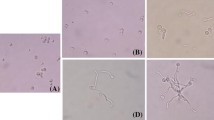Abstract
A series of 2-arylamino-5-hydroxy-naphthalene-1,4-diones, 3-arylamino-5-methoxy-naphthalene-1,4-diones, and 2-arylamino-3chloro-5-hydroxy-naphthalene-1,4-diones were synthesized and tested forin vitro antifungal activity against the speciesCandida andAspergillus niger. Among those tested, 3-arylamino-5-methoxy-naphthalene-1,4-diones exhibited potent antifungal activity. In general, the 3-arylamino-5-methoxy-naphthalene-1,4-diones showed more potent antifungal activity than the 2-arylamino-5-hydroxy-naphthalene-1,4-diones and the 2-arylamino-3-chloro-5-hydroxy-naphthalene-1,4-diones.
Similar content being viewed by others
References
Cai, L., Wei, G.-X., van der Biji, P., and Wu, C. D., Namibian chewing stick,Diospyros lycioides, contains antibacterial compounds against oral pathogens.J. Agric. Food Chem., 48, 909–914 (2000).
Cameron, D. W. and Riches, A. G., Reaction of 2-acetoxy-3-chloro and 2,3-diacetoxy naphthoquinones with 1,3-dioxy and 1,1,3-trioxy butadienes.Aust. J. Chem., 52, 1165–1171 (1999).
Hannan, R. L., Barber, R. B., and Rapoport, H., Synthesis of bromonaphthoquinones from 1,5-dimethoxynaphthalene.J. Org. Chem., 44, 2153–2158 (1979).
Inbaraj, J. J. and Chignell, C. F., Cytotoxic action of juglone and plumbagin: A mechanistic study using HaCaT keratinocytes.Chem. Res. Toxicol., 17, 55–62 (2004).
Kelly, T. R., Parekh, N. and Trachtenberg, E. N., Regiochemical control in the Diels-Alder reaction of substituted naphthoquinones. The directing effects of C-6 oxygen substitutents.J. Org. Chem., 47, 5009–5013 (1982).
Krungkrai, J., Kanchanarithisak, R., Krungkrai, S. R., and Rochanakij, S., Mitochondrial NADH dehydrogenase fromPlasmodium falciparum andPlasmodium berghei.Exp. Parasitol., 100, 54–61 (2002).
Mcginnis, M. R. and Rindali, M. G.Antibiotics in Laboratory Medicine (4th ed.); Lorian, V., Ed.; Williams and Wilkins: Baltimore, pp 176–211 (1996).
Middleton, R. W. and Parrick, J., InThe Chemistry of The Quinonoid Compounds; Patai, S., Rappoport, Z., Eds.; John Wiley & Sons: London, 1988; Vol.2, pp 1019–1066.
Naruta, Y. and Maruyama, K., InThe Chemistry of The Quinonoid Compounds; Patai, S., Rappoport, Z., Eds.; John Wiley & Sons: New York, 1988; Vol. 2, pp 292–303.
Roberts, H., Choo, W. M., Smith, S. C., Marzuki, S., Linnane, A. W., Porter, T. H. and Folkers, K., The site of inhibition of mitochondrial electron transfer by coenzyme Q analogs.Arch. Biochem. Biophys., 191, 306–315 (1978).
Ryu, C.-K., Song, E. H., Shim, J.-Y., You, H.-J., Choi, K. U., Choi, I. H., Lee, E. Y. and Chae, M. J., Synthesis and antifungal activity of 2,5-disubstituted-6-arylamino-4,7-benzimidazolediones.Bioorg. Med. Chem. Lett., 13, 17–20 (2003).
Ryu, C.-K. and Kim, D. Y., The synthesis and antimicrobial activities of some naphthalene-1,4-diones (II).Arch. Pharm. Res., 15, 263–268 (1992).
Salmon-Chemin, L., Buisine, E., Yardley, V., Kohler, S., Debreu, M.-A., Landry, V., Sergheraert, C., Croft, S. L., Krauth-Siegel, R. L., and Davioud-Charvet, E., 2- and 3-Substituted 1,4-naphthoquinone derivatives as subversive substrates of trypanothione reductase and lipoamide dehydrogenase fromTrypanosoma cruzi: Synthesis and correlation between redox cycling activities andin vitro cytotoxicity.J. Med. Chem., 44, 548–565 (2001).
Thomson, R. H., InNaturally Occurring Quinones III. Recent Advances, Chapman and Hall, London (1987), pp. 127–343.
Thomson, R. H., Studies in the juglone series. I. Some halogen derivatives and their reaction with aniline.J. Org. Chem., 13, 377–383 (1948).
Wang, H., Mao, Y., Chen, A. Y., Zhou, N., LaVoie, E. J. and Liu, L. F., Stimulation of topoisomerase II-mediated DNA damagevia a mechanism involving protein thiolation.Biochemistry, 40, 3316–3323 (2001).
Author information
Authors and Affiliations
Corresponding author
Rights and permissions
About this article
Cite this article
Ryu, CK., Chae, M.J. Synthesis and antifungal activity of naphthalene-1,4-diones modified at positions 2, 3, and 5. Arch Pharm Res 28, 750–755 (2005). https://doi.org/10.1007/BF02977337
Received:
Issue Date:
DOI: https://doi.org/10.1007/BF02977337




